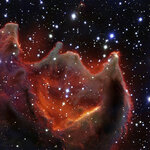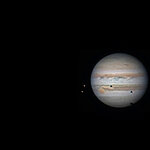Space
Apparently, PLANCK says that BICEP2 did not detect gravitational waves. The signal was mostly intergalactic dust. That is my reading of a Google translate translation of an official Planck website. This is even more tentative and un-reviewed than the arXiv postings that often set off a big story. However, if this holds true it seems that BICEP2 did not indeed detect gravitational waves. This may have officially finally settled the matter of BICEP2.
They took the original website down But here is a link to it on the wayback machine (http://web.archive.org…

To put it briefly, the habitability of a planet depends on it's distance from its star, the composition of its atmosphere, and the type of star its orbiting. If our own solar system is at all typical then planets like those known around Kepler 444 and reported in the paper arXiv:1501.06227 do not have atmosphere or have a Venus like atmosphere. If there is another Earth size planet to be found, father out, where it's a bit cooler it could be a home for life. If it did have life that life could, due to the age of the planet, have been in existence long before…

What exactly is cometary globule CG4?
That's still a bit of a mystery. Despite the name, it has nothing to do with comets. In 1976, several elongated comet-like objects were discovered in pictures taken with the UK Schmidt Telescope in Australia. Because of their appearance, and despite any connection with comets, they became known as cometary globules. They were all located in a huge patch of glowing gas called the Gum Nebula. They had dense, dark, dusty heads and long, faint tails, which were generally pointing away from the Vela supernova remnant located at the center of the Gum…

The first radar images of asteroid 2004 BL86, which made its closest approach today at 8:19 a.m. PST - a distance of only 745,000 miles (3.1 times the distance from Earth to the moon) - reveal that it even has its own small moon.
The closeness did not take anyone by surprise. Asteroid 2004 BL86 was discovered on Jan. 30, 2004, by the Lincoln Near-Earth Asteroid Research (LINEAR) survey in White Sands, New Mexico and its trajectory is well understood. Monday's flyby was the closest approach the asteroid will make to Earth for at least the next 200 year and is the closest a known asteroid this…

Astronomers have discovered a ring system eclipsing the very young Sun-like star J1407.
And it is huge, much larger and heavier than the ring system of Saturn. The ring system, the first of its kind to be found outside our solar system, was discovered in 2012 and the new data analysis shows that it consists of over 30 rings, each of them tens of millions of kilometers in diameter.
There are gaps in the rings, which indicate that satellites ("exomoons") may have formed.
"The details that we see in the light curve are incredible. The eclipse lasted for several weeks, but you see rapid…

Ten years ago, on Jan. 14, 2005, some orange-y image, showing an alien scenery with lots of pebbles in the horizon, was at the center of ESA scientists’ attention.
The snapshot of a distant world’s landscape was truly amazing. It was Saturn’s moon Titan with an orange surface seen through the lens of ESA’s Huygens lander, an exciting one-of-a-kind experience for European scientists as they can proudly say:
“We’ve landed there!” And “there” means the outer solar system where no probe has ever landed before. ESA scientist Claudio Sollazzo, who was the Mission Operations Manager in the…
By Anton Wallner, Australian National University
Our understanding of heavy element production in supernovae, exploding stars way beyond our solar system, may need to change following some discoveries we have made looking not to the skies, but deep under our oceans.
Supernova explosions are one of the most violent events in our galaxy and are thought to produce elements essential for life such as iron and iodine but also some of the heaviest elements existing in nature.
When a star goes supernova and explodes, these heavy elements are thrown out into space as dust and debris.
This material,…

Two teams of astronomers have used computer models to look back nearly 13 billion years, when the Universe was less than 10 percent its present age, to determine how quasars - extremely luminous objects powered by supermassive black holes with the mass of a billion suns - regulate the formation of stars and the build-up of the most massive galaxies.
Using a combination of data gathered from powerful radio telescopes and supercomputer simulations, the teams found that a quasar spits out cold gas at speeds up to 2000 kilometers per second, and across distances of nearly 200,000 light years -…

Jupiter's moons are giving us a show not seen since 2013: The orbital path of the moons is tilting edge-ion to the Earth and the sun, making it possible to watch the moons pass in front of each other, an occultation, or pass through another moon's shadow, an eclipse, and even cast tiny black shadows onto Jupiter.
Even through the smallest telescope or binoculars you should be able to see the two prominent belts on either side of Jupiter's equator and the four Galilean moons: Io, Europa, Ganymede and Callisto. Jupiter rises by 10:30 p.m. at the beginning of the month and by 8:30 at the end of…

Geologists have discovered hidden magnetic messages from the early solar system in meteorites measured
using the PEEM-Beamline
at the BESSY II synchrotron located in The Helmholtz-Zentrum Berlin für Materialien und Energie (HZB).
The information captures the dying moments of the magnetic field during core solidification on a meteorite parent body, providing a sneak preview of the fate of Earth's own magnetic field as its core continues to freeze.
Meteorites were previously thought to have poor magnetic memories, with the magnetic signals they carry having been written and rewritten many…